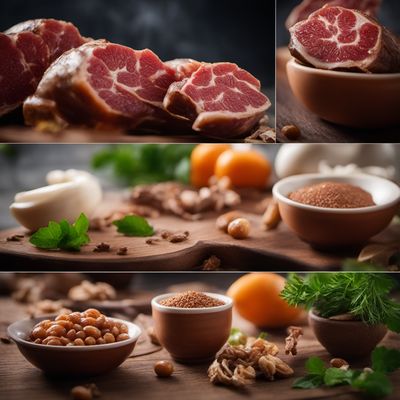
Ingredient
Asses-mules-hinnies carcase
The Forgotten Meat
Asses-mules-hinnies carcase, also known as donkey meat, is a lesser-known meat that has a rich historical background and unique culinary potential. Although not as widely consumed as other meats, it offers a distinct flavor and texture that can be enjoyed in various dishes.
Origins and history
The consumption of donkey meat has historical roots in different cultures around the world. It has been utilized for centuries due to its availability, nutritional value, and versatility in cooking. While it may not be as popular as other meats in modern times, it still holds cultural significance in certain regions.
Nutritional information
Asses-mules-hinnies carcase is a good source of protein, vitamins, and minerals. It is lower in fat compared to some other meats, making it a healthier option. However, it is important to note that the nutritional content may vary depending on the specific cut and preparation method.
Allergens
Asses-mules-hinnies carcase does not pose any known allergens. However, individuals with specific dietary restrictions or preferences should always check the ingredients and preparation methods of dishes containing this meat.
How to select
When selecting asses-mules-hinnies carcase, choose cuts that are fresh, firm, and free from any unpleasant odors. Look for meat that has a deep red color and minimal visible fat. If purchasing from a butcher, inquire about the source and quality of the meat to ensure its freshness and authenticity.
Storage recommendations
To maintain the freshness and quality of asses-mules-hinnies carcase, store it in the refrigerator at a temperature below 4°C (40°F). Keep it wrapped in plastic or butcher paper to prevent exposure to air and potential cross-contamination. Use it within a few days of purchase or freeze it for longer storage.
How to produce
Producing asses-mules-hinnies carcase at home requires specialized knowledge and facilities. It is not a common practice for amateur cooks or individuals to raise donkeys or mules for meat production. If interested in experiencing this meat, it is recommended to seek out reputable suppliers or restaurants that offer it on their menu.
Preparation tips
Asses-mules-hinnies carcase can be prepared in various ways, including braising, stewing, roasting, or grilling. Slow cooking methods are often preferred to tenderize the meat and enhance its flavors. It pairs well with robust herbs, spices, and aromatic ingredients that complement its gamey taste.
Culinary uses
Asses-mules-hinnies carcase is traditionally used in regional dishes of certain countries, such as China, Italy, and Mexico. It can be incorporated into stews, ragùs, sausages, or cured meats. It is also enjoyed in burgers, meatballs, or as a filling for savory pastries. Its unique flavor adds a distinctive touch to these dishes.
Availability
Asses-mules-hinnies carcase is commonly available in specific regions or countries where it is culturally accepted and consumed. It may be found in local markets, specialty butcher shops, or restaurants that specialize in regional cuisine.
More ingredients from this category » Browse all

Duck carcase
The Essence of Duck: Unveiling the Secrets of Duck Carcase

Wild boar carcase
Untamed Bounty: Wild Boar

Chicken carcase
The Foundation of Flavor: Unleashing the Potential of Chicken Carcase

Deer carcase
Venison: The Wild Delicacy

Goose carcase
The Flavorful Foundation

Pig carcase
Pig Carcase: A Versatile Ingredient

Ratites carcase
The Exotic Delicacy: Ratites Carcase Unveiled

Goat carcase
The Wholesome Base

Sheep carcase
The Art of Lamb: Exploring the Versatility of Sheep Carcass

Rabbit carcase
The Art of Rabbit: Unlocking the Culinary Potential of Rabbit Carcass

Bovine carcase
The Foundation of Flavor

Turkey carcase
The Versatile Turkey Carcase